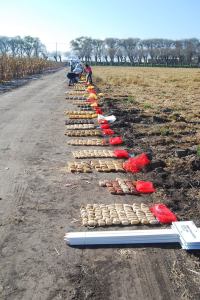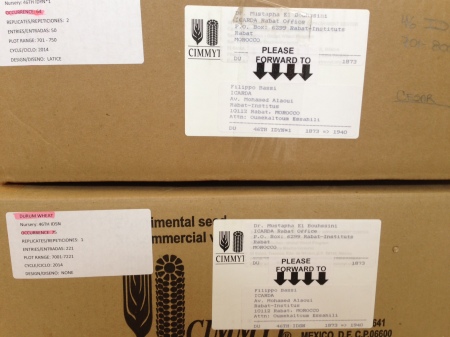Anne Vezina pushes back:
But there are funds for the GM banana. Should the project be stopped? What kind of reasons would warrant taking such a step?
Value for money, perhaps? Have your say!
Agrobiodiversity is crops, livestock, foodways, microbes, pollinators, wild relatives …
Anne Vezina pushes back:
But there are funds for the GM banana. Should the project be stopped? What kind of reasons would warrant taking such a step?
Value for money, perhaps? Have your say!
The Gates Foundation has sunk $15 million into developing GMO ‘super bananas’ with high levels of pre-Vitamin A, writes Adam Breasley. But the project is using ‘stolen’ genes from a Micronesian banana cultivar. And what exactly is the point, when delicious, popular, nutritious ‘red bananas’ rich in caroteinoids are already grown around the tropics?
That provocative lede to an article in The Ecologist provoked a number of responses when I posted it on Facebook 1. As not everyone can post comments there, and nobody at all can post comments at The Ecologist, I’ve decided to move the whole thing here.
A couple of comments were actually questions. Anastasia Bodnar asked: Are the existing red banana cultivars suitable for growing where this new variety is intended to be grown? And Sarah Hearne added: And do the red bananas have the same farmer/consumer acceptance in East African and beyond as existing varieties? Good questions all. And Alexandra Zum Felde addressed them, and more, in her comment:
Red bananas — at least ones like those in the photo, not Fe’i bananas — can and are grown where Cavendish are grown (so basically all over the tropics), though they — like many traditional cultivars — are not as productive as Cavendish bananas. But Cavendish are not the issues here — in Uganda the staple banana is Matooke (East African Highland Banana), of which over 180 cultivars exists … and all of which are pretty beta-carotene poor … but local leafy vegetables are full of (pro)vitamins! It would be easier and more cost-effective to re-vamp the image and attractiveness of traditional foods, than to introduce one single GMO variety.
So, are red bananas, whether traditional cultivars or the ones genetically engineered in an Australian lab, the wrong answer to the right question? Discuss.
On that issue of collaboration between national programmes and international genebanks, which we alluded to yesterday when we were talking about ICARDA and Morocco, it might be worth highlighting another example. We Nibbled this before, but it can stand a bit more exposure.
The new genebank of Embrapa, which opened in April this year at Cenargen, one of the 46 units of the Brazilian Agricultural Research Corporation in Brasilia, received today (06/11) the first deposit from an international collection of plant genetic resources. This is a backup of [part of] the potato collection from CIP (International Potato Center) in Peru, which has four thousand samples of wild species and cultivated varieties, and is the most diverse and extensive in the world, as the country [together with neighbours] is the genetic cradle of this Andean crop. This first instalment consisted of 180 [in vitro] samples from nine varieties. The next shipment will be sent in February 2015 and by the middle of next year, probably the whole collection will have arrived in Brazil.
That’s a translation from an Embrapa press release, 2 by me via Google Translate. Vegetatively propagated (or clonal) crops such as potato and cassava, which are conserved in the field and in tissue culture, require a bit more effort for safety duplication compared to seed crops. See, for example, what’s going on with bananas. It’s great to see CIP and Embrapa coming together in this way. Maybe Embrapa could also eventually safety duplicate in reciprocal fashion its own collections in the international centres. Its cassava clonal collection is very important, for example, and not safety duplicated. Look at Table 3 on page 21 of the global cassava conservation strategy (pdf), and then read the discussion on page 41:
Column 14 [of Table 3] indicates the importance of introducing national program accessions that are not yet represented in the international centers, for safety duplication (see also later sections). These low, medium and high priorities are based on number of in situ or ex situ materials not yet at CIAT or IITA, and the relative importance of that country’s cassava genetic diversity. Critical countries for further representation in the international centers are: Brazil, Peru, Republic of Congo, Côte d’Ivoire, D.R. Congo, Malawi, Mozambique, Rwanda, Uganda and Tanzania, along with several other countries of medium urgency.
Some seeds from Embrapa are already in Svalbard. But there’s no Svalbard for clonal collections, alas.
 Readers may remember that last Friday was the day to be in Toluca, Mexico to see high-latitude Andean maize varieties being multiplied up by the CIMMYT genebank for the very first time. Well, Dr Denise Costich, who is in charge of that genebank, now tells us that it all went off without a hitch. I hope she won’t mind me reproducing her post and one of her photographs here for any maize aficionados who are not on Facebook.
Readers may remember that last Friday was the day to be in Toluca, Mexico to see high-latitude Andean maize varieties being multiplied up by the CIMMYT genebank for the very first time. Well, Dr Denise Costich, who is in charge of that genebank, now tells us that it all went off without a hitch. I hope she won’t mind me reproducing her post and one of her photographs here for any maize aficionados who are not on Facebook.
By all accounts, our “Day of High-Altitude Maize” was a success! It was a bit crazy, with our catalogs arriving at the field just before our participants, but, they turned out well in the end. It was great to have Tom Payne and his team from the CIMMYT Wheat Bank there, and also Darell Sison, whom I really appreciate for his enthusiasm and interest in what we do. Tremendous thanks to my team, who worked really hard getting everything ready, and participated fully in the activities on the day–answering questions, acting as guides setting up the displays, taking everything down (very rapidly) as the rain clouds rolled in, etc. That includes Marcial Rivas, Cristian Zavala, Eduardo Velázquez and Paulina Gonzalez, among many others! A special shout out goes to Alex Velazquez, who helped out on so many different things–the invitation, the catalog, all were improved because of his dedication. We had a great discussion afterwards, making lists of what we did well, and what we need to improve…we’re already planning the next field day! the only thing we are really sad about is that we were so busy, we didn’t remember to take a photo of the Maize Bank staff–for the first time ever we had the whole permanent staff, from all three stations, in one place…here are a few photos to capture a bit of the action…
By the way, the maize genebank at CIMMYT does have a Facebook page, so if you want to follow their activities, go and “like” it.
Talking of the genebanks of CGIAR and their fieldwork, the week before last I was in Morocco seeing at first hand how another centre, ICARDA, is organizing itself now that access to its buildings and fields at Tel Hadya near Aleppo is so problematic. ICARDA now has a North Africa Platform, based in Morocco, bringing together most of its breeders as well as the genetic resources section. The Institut National de la Recherche Agronomique (INRA) has given the centre 100 hectares at the Marchouch Station for use by these programmes. Here’s what the fields looked like about a week ago, ready for use for upcoming breeders’ trials and various genebank activities.
The actual station is in the distance, among the trees. Staff there were busy preparing seed when we visited.

Those seeds included international nurseries from that other CIMMYT genebank, the wheat one, mentioned by Denise. 3 Here’s proof, if any were needed, that collaboration among CGIAR centres, and especially their genebanks, is alive and well.

Best wishes to ICARDA in general, and the genebank in particular, on its strategic decentralization, and its exciting new relationship with the national programme in Morocco. And congratulations to CIMMYT for what sounds like a very successful outreach activity in Toluca last week.